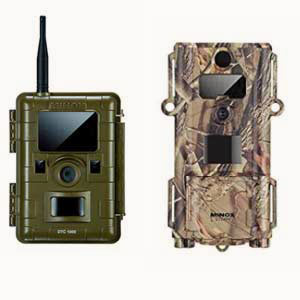Pratique | Équipement
Utiliser les pièges photographiques pour étudier et observer les oiseaux

Les pièges photographiques Minox DTC-1100 (à gauche) et DTC-450 (à droite) : nous avons pu les tester en septembre 2016.
Introduction
Un piège photographique est un appareil capable de photographier de jour comme de nuit un sujet passant devant lui grâce à un capteur qui détecte les variations de chaleur et/ou les mouvements. Cet équipement, autrefois réservé aux scientifiques et aux professionnels, devient de plus en plus populaire grâce à la réduction des prix et à des performances accrues, et désormais de nombreux modèles sont disponibles.
On peut utiliser un piège photographique pour étudier et observer les oiseaux en pleine nature ou dans un jardin. Et découvrir les images stockées sur la carte mémoire est un vrai plaisir.
Dans cet article, nous vous donnons des conseils pratiques pour choisir, installer et utiliser des pièges photographiques, nous présentons les résultats de nos essais des Minox DTC-450 et DTC-1100, nous proposons une sélection de modèles adaptés aux besoins des ornithologues et nous énumérons quelques exemples d’études ornithologiques utilisant ce type d’équipement.
Abstract
A camera trap is a remotely activated camera that is equipped with a motion sensor or an infrared sensor, or uses a light beam as a trigger. This equipment, once reserved for scientists and professionals, is increasingly popular thanks to the reduction of their prices and their increasingly performance, and now many models are available. A camera trap can be used to study and watch birds in the wilderness or in a garden. And discovering the images stored on the memory card is a real pleasure.
In this article we give you practical tips for choosing, installing and using camera traps, we present the results of our tests of the Minox DTC-450 and DTC-1100, we propose you a selection of models suitable for ornithologists and we list some examples of ornithological studies using this type of equipment.
Poursuivez la lecture de cet article, en vous abonnant dès maintenant !
Découvrez les Archives d’Ornithomedia.com
Pour seulement 10,00 €TTC/an (ou 6,00 € les 6 mois)
Profitez de plusieurs centaines d’articles en accès illimité et sans aucun engagement.
Compléments
À lire aussi sur Ornithomedia.com
- Utiliser une caméra thermique de vision nocturne pour étudier et observer les oiseaux
- Compter les oiseaux aquatiques
- Un cas de cannibalisme chez le Faucon d’Éléonore
Produits recommandés
- Camera Trapping for Wildlife Research de Francesco Rovero et Fridolin Zimmermann
- Moultrie 150 Panoramic
- SpyPoint HD-7
- Bushnell HD Natureview 119740
- Minox DTC-650
- Minox DTC-450
- Minox DTC-1100
- Bushnell Trophy Cam HD Agressor
- Bushnell Essential E2
- Acorn Ltl Acorn 6210 mm
Sources
- Francesco Rovero et Fridolin Zimmermann (2016). Camera Trapping for Wildlife Research. Pelagic Publishing
- Anastasia Miliou, Thodoris Tsimpidis, Vidar Selås e Geir A. Sonerud (2016). Nonparental Infanticide in Colonial Eleonora’s Falcons (Falco eleonorae). Journal of Raptor Research. Volume : 50. Numéro : 2 . Pages : 217-220. www.bioone.org/doi/abs/10.3356/0892-1016-50.2.217?journalCode=rapt
- Diemer Vercayie (2016). Manuel des pièges photographiques. Natuurpunt. www.natuurpunt.be
- Richard Inger et al (2016). Ecological role of vertebrate scavengers in urban ecosystems in the UK. Ecology and Evolution. Date : 09/09. http://onlinelibrary.wiley.com/doi/10.1002/ece3.2414/full
- Lindsay Patterson, Riddhika Kalle et Colleen Downs (2016). Predation of artificial bird nests in suburban gardens of KwaZulu-Natal, South Africa. Urban Ecosystem. Juin. http://link.springer.com/article/10.1007/s11252-016-0526-4
- Thunhikorn et al (2016). Field methods for loud-calling Peacock-pheasant. Assessing the population of grey peacock-pheasant (Polyplectron bicalcaratum) in a Southeast Asian conservation landscape. Raffles Bulletin of Zoology. Numéro : 64. Pages : 302-312. http://lkcnhm.nus.edu.sg
- Amy King et al (2016). Patterns of salt lick use by mammals and birds in northeastern Cambodia. Cambodian Journal of Natural History. Numéro : 1. Pages : 40–50. www.researchgate.net
- Javier A. Rivas-Romero et Jose Roberto Soto-Shoender (2015). Filling in the Gaps: Evaluating the Use of Camera Traps in the Canopy to Examine Frugivore Visits to Oreopanax echinops in the Highlands of Guatemala. The Southwestern Naturalist. Volume : 60. Numéro : 4. Pages : 366-370. www.bioone.org/doi/abs/10.1894/0038-4909-60.4.366?journalCode=swna




Aucun commentaire sur ce sujet
Participer à la discussion !